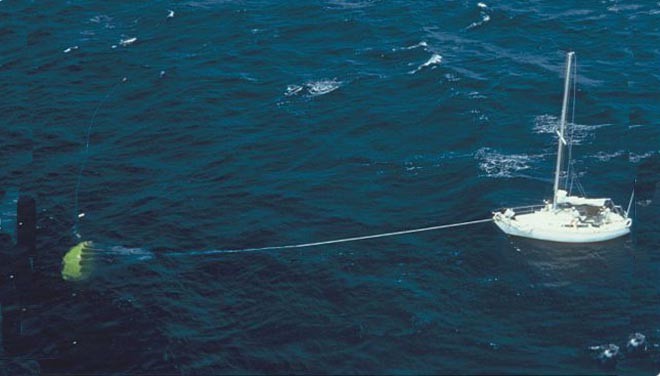Sea anchor - do you know how to use yours to save your life?
by Sail-World Cruising on 14 Feb 2012

Sea anchor deployed from the bow - not the recommended angle SW
A sea anchor, like an EPIRB, is something one hopes never to have to use. However, it can save your life, so it's not much use having it take up valuable stowage space unless you know how to use it.
Zack Smith is one of the world's foremost experts in sea anchors and heads para-anchor manufacturer Fiorentino's Research and Development Team.
One of Zack's most important pieces of advice stems from his 'Constant Rode Tension' Theory, which he developed during more than 15 years of sea-trials at Fiorentino. The theory states that 'keeping rode taut is the key to successful parachute anchor and storm drogue use.'
This year Zack will be espousing his theory at boat shows in the USA (see below for those fortunate enough to be close enough to attend), but his theory is known to run counter to current industry standards which recommend paying out long lengths of rode to add more stretch to the system and adding weight at the boat not next to the safety device.
Critics say Fiorentino’s 'Constant Rode Tension Solutions' will 'stretch rode out too much' and cause it to break.
Fiorentino maintains that the industry’s current standard operating procedure is leading to too much slack rode resulting in excessive shock loading that can break equipment and cause drag devices to fail.
Zack has this advice for those who keep a sea anchor on their sailing boat:
'My best advice is to go out and practice different approaches in sloppy weather; drag rode bights off the stern, hove to in 25 knots, deploy a para-anchor---don't limit yourself to just one trick.
'Like the Pardeys, I prefer a passive approach to heavy weather sailing. Tests prove that heaving to with a para-anchor works. All it takes is balance between the para-anchor and the boat, achieved through reduced sail, rudder positioning, length of rode, and a properly rigged para-anchor.
'Rode length and how well a person understands their boat is what normally dictates how comfortably they will ride to a para-anchor. Exhaustion reinforces the importance of passive storm management.
'dashewoffshore.com!Steve_Dashew provides good information on the various steps and types of active approaches. During storm trials, I use active tactics just to get back to port before nightfall.
'Passive or active? Both. Develop a plan to handle all 'what if...' scenarios for heavy weather problems in accordance with any emergency that can occur offshore. Practice with your gear until you confidently hold a full bag of tricks.'
To see a video of Zack explaining his advice on the best method of deploying a para-anchor, click the link below, remembering that the angle most recommended for sailing boats is at 2.30pm, rather than 1.00pm for powerboats:
http://youtu.be/-y7kCAZ1G2k!Zack_describing_how_to_deploy_a_parachute_anchor
The seminars:
The importance of keeping constant tension on rode when using parachute sea anchors and storm drogues will be the focus of Fiorentino’s 2012 boat show safety seminars by Zack.
During his seminars, Zack will discuss the importance of short rode deployment (paying out rode in short increments as sea states change). He also will explain why weight should be placed next to the drag device instead of the boat end to keep the canopy inflated and reduce stretch in the system.
Additionally, the seminars will include information on Fiorentino’s fixed and pendant line bridle set-ups and their unique 'Free Flying' riding sail which are critical components in keeping rode taut. Sea trial video of these pioneering rigging set-ups will be available on www.para-anchor.com later this year.
Load cell research completed during 15 years of sea trials by Zack and Fiorentino’s Research and Development Team revealed that shorter rode lengths, weight placement, use of rope with less stretch and increasing vessel speed with engine and sail power can drastically reduce shock loading on equipment during changing seas because slack is kept to a minimum. Fiorentino believes that long periods of slack rode are the primary cause of problems with drag devices.
Zack, who is known for providing unbiased comparisons on a wide range of drag devices, will discuss the pros and cons of both operational theories so sailors can determine which system best fits their needs.
Boat Show and Seminar Schedules:
Pacific Sail Expo
April 12-15, 2012
Jack London Square
Phone: 401-841-0900
Miami International
Boat Show
February 16-20, 2012
Miami Beach Convention
Center Phone: 305-531-8410
Booth # 2653, 2744, 2748 convention center
Seminar Schedule Strictly Sail Miami:
Tent B -- Saturday 2/18/12 10:30 AM
Tent C -- Monday 2/20/12 11:45 AM
If you want to link to this article then please use this URL: www.sailworldcruising.com/93884